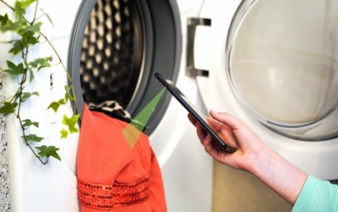04/10/2023 – Research — auf Deutsch lesen
Checking items of clothing using a smartphone
Researchers at Fraunhofer have developed an ultra-compact near-infrared spectrometer suitable for recognizing and analyzing textiles.
Mixed fabrics can also be reliably identified through the combination of imaging, special AI (artificial intelligence) algorithms and spectroscopy. The technology could be used to optimize recycling old clothing, so old apparel could be sorted according to type. A highly miniaturized version of the system can even fit into a smartphone. This could lead to a host of new applications for end-users in everyday life — from checking clothes when out shopping to detecting counterfeits.
How does textile analysis work?
Infrared spectrometers are powerful measuring instruments when it comes to non-destructive analysis of organic materials. The Fraunhofer Institute for Photonic Microsystems IPMS in Dresden has recently developed a spectral analyzer system that recognizes and analyzes textile fabrics. The system can also reliably recognize mixed fabrics. Researchers at Fraunhofer rely on near-infrared (NIR) spectroscopy to achieve the required reliability and accuracy when identifying textiles. The system works for wavelengths between 950 and 1900 nanometers, which is close to the visible spectrum. Advantages of near-infrared technology include being easy to use and having a wide range of applications.
Firstly, a conventional camera module captures an image of the garment. The AI selects a specific point from the fabric’s image data to be examined by the spectral analyzer module. Light reflected from the fabric is captured by the spectrometer module. There, it passes through an entrance slit, is transformed into parallel light beams using a collimating mirror and projected onto a grating using a scanning mirror. Depending on the angle of incidence and exit, the grating splits the light beams into different wavelengths. Light reflected from the grating is directed by the scanner mirror to a detector which captures the light as an electrical signal. An A/D converter then digitizes these signals, which are subsequently analyzed in the signal processor. The resulting spectrometric profile for the textile fabric reveals which fibers it is made from by comparing to a reference database. “The optical resolution is 10 nanometers. This high resolution means the NIR spectrometer can also use AI to identify mixed fabrics such as items of clothing made from polyester and cotton,” says Grüger.
Application possibilities
Grüger sees an important application for the AI-controlled spectrometer when it comes to recycling. NIR spectroscopy could improve recycling efficiency and reduce the mountain of old clothing. This would enable companies that recycle old clothing to sort it more efficiently and faster. Spectroscopic identifies and sorts textiles more accurately and much faster than a human can.
If NIR spectroscopy was to be integrated into a smartphone, end-users might also benefit: When buying clothes, a quick check with the smartphone shows whether the product actually delivers what it promises. And should the label with the cleaning instructions no longer be legible, the smartphone has a textile scanner to identify the fabric and so determine the appropriate wash cycle.
Researchers at Fraunhofer IPMS can even envisage applications beyond the textile industry. Smartphones fitted with spectrometers might be used to provide information about the quality of groceries such as fruit and vegetables when out shopping. The technology might conceivably also be used to examine skin.




